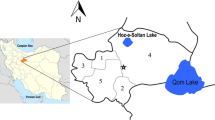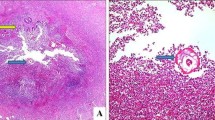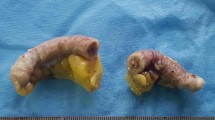Abstract
Enterobius vermicularis is one of the most common intestinal parasite in human. The main objective of this study is to determine the role of E. vermicularis in appendicitis through histopathological examination. A cross sectional study included 200 patients who had appendectomy from three hospitals in Gaza strip. The inflamed appendix was the cause of attending the hospital. Histopathological examination for each appendix was carried out. A questionnaire was designed (interview with patients who underwent appendectomy), and information were obtained from patient and analyzed by using SPSS. The study showed that 30 (15.0 %) of 200 appendices had E. vermicularis in histopathological examination. It was found that ages of patients with histologically proven E. vermicularis in appendices less than 18 years old was found to be (18.2 %). Regarding sex, (16.5 %) of females, (14.0 %) of males patients had E. vermicularis in appendices. Patients who had the highest infection with E. vermicularis were students (17.3 %). In conclusion E. vermicularis occurs more frequently inflamed appendices than in normal. From these results we can conclude that E. vermicularis could be associated to cause of appendicitis in Gaza strip.


Similar content being viewed by others
References
Akhigbe T, Smith F, Adeyemo A, Adeyanju T, Condon E, Waldron D.(2013) Pinworm And Appendicitis In Children. The Internet J Surgery 30(3)
Al-Hindi AI (2002) Prevalence of some intestinal parasites among school children in Deir-El-Balah town, Gaza strip, Palestine. Ann Saudi Med 22:3–4
Al-Hindi AI (2009) Diagnosis of gastrointestinal parasites among hospitalized patients attending Al-Nasser Paediatric Hospital, Gaza, Palestine. J Public Health 17:49–53
Al-Hindi AI, AL-Louh M (2013) Trends of Intestinal Parasites Prevalence in Gaza Strip, 1998-2007: The Use of Government Health Records. Turk J Med Sci 43:652–659
Al-Hindi A, Basil B, El-Kariri M (2013) Enterobiasis among pre-school children in Gaza strip. J Al Azhar Univ-Gaza (Natural Sciences) 15:53–70
Arca MJ, Gates RL, Groner JI, Hammond S, Caniano DA (2004) Clinical manifestations of appendiceal pinworms in children: an institutional experience and a review of literature. Pediat Surg Int 20:372–375
Aydin O (2007) Incidental parasitic infestations in surgically removed appendices: a retrospective analysis. Diag Pathol 2:16
Baert AC (1999) Appendicitis. In: Peterson Holger, Allison David (eds) The encyclopedia of medical imaging. Oslo, The Nicer Institute
Batistatou A, Solota V, Scopa CD (2002) Images in pathology: oxyuris (Enterobius vermicularis) in human cecum and appendix. Int J Surg Pathol 10:58
Budd JS, Armstrong C (1987) Role of Enterobious vermicularis in the etiology of appendicitis. Br J Surgery 78:74–89
Burkhart CN, Burkhart CG (2005) Assessment of frequency, transmission, and genitourinary complications of enterobiasis (pinworms). Int J Dermatol 44:837–840
Cook GC (1994) Enterobius vermicularis infection. Gut 35:1159–1162
Cook CG, Zumla IA (2003) Manson’s tropical disease, 21st edn. W. B. Saunders Ltd, Philadelphia
Fallah E, Dehgani A (2011) A study on Enterobius vermicularis infection in a appendices removed by surgery in Tabriz Hospitals. Int J Parasitic Dis ™ ISSN: 1559-4629 01/2011; 4
Gialamas E, Papavramidis T, Michalopoulos N, Karayannopoulou G, Cheva A, Vasilaki O, Kesisoglou I, Papavramidis S (2012) Enterobius vermicularis: a rare cause of appendicitis. Turkiye Parazitol Derg 36:37–40
Gutiérrez Y (2000) Diagnostic pathology of parasitic infections with clinical correlations (second edition). Oxford University Press. pp. 354–366. ISBN 0-19-512143-0
Helmy AH, Abou Shousha T, Magdi M, Sabri T (2000) Appendicitis; appendectomy and the value of endemic parasitic infestation. Surgery and Pathology Departments, Theodore Bilharz Research Institute. Egyp J Surg 19:87–91
Hussein AS (2011) Prevalence of intestinal parasites among school children in northern districts of West Bank-Palestine. Trop Med Int Health 16(2):240–244. doi:10.1111/j.1365-3156.2010.02674.x
Hwang KP, Tsai WS, Lincy LN (2002) Detection of Enterobius vermicularis eggs in the submcosa of the transversecolon of a man presented with colon carcinoma. Am J Trop Med Hyg 67:546–548
Kucik CJ, Martin GL, Sortor BV (2004) Common intestinal parasites. Am Family Phys 69:1161–1168
Marjorie J, Arca R, Gates L, Groner JI, Hammond S, Caniano DA (2004) Clinical manifestations of appendiceal pinworms in children. An institutional experience and a review of the literature. Pediat Surg Int 20:372–375
Ministry of Health (2014) Surgery Department records, Gaza
Mogensen K, Pahle E, Kowalski K (1985) Enterobius vermicularis and acute appendicitis. Acta Chirurgica Scand 151:705–707
Quasem A, Salam A (2007) Ectopic enterobiasis: a case report and review of literature. Pak J Med Sc 23:785–787
Ramezani MA, Dehghani MR (2007) Relationship between Enterobius vermicularis and the incidence of acute appendicitis. Southeast Asian J Trop Med Public Health 38:20–23
Sah SP, Bhadani PP (2006) Enterobius vermicularis causing symptoms of appendicitis in Nepal. Trop Doct 36:160–162
Saxena AK, Springer A, Tsokas J, Willital GH (2001) Laparoscopic appendectomy in children with Enterobius vermicularis. Surg Lap End Perc Tech 11:284–286
Shtayeh A, Hamdan AH, Shaheen SF, Abu-Zeid I, Faidy YR (1989) Prevalence and seasonal fluctuations of intestinal parasites infections in Nablus area, West Bank of Jordan. Ann Trop Med Parasitol 83:67–72
Shubair ME, Yassin MM, Al-Hindi AI, Al-Wahaidi AA, Jadallah SY, Abu Shaaban ND (2000) Intestinal parasites in relation to haemoglobin level and nutritional status of school children in Gaza. J Egypt Soc Parasitol 30:365–375
Silva DF, Silva RJ, Silva MG, Sartorelli AC, Rodrigues MA (2007) Parasitic infection of the appendix as a cause of acute appendicitis. Parasitol Res 102:99–102
Stephan S, Marks DS, Smith P, El Habbal MH, Lewis S (2006) The great Ormond street color handbook of pediatrics and child health
Wiebe K (1991) Appendicitis and Enterobius vermicularis. Scan J Gast 26:336–338
Yassin MM, Shubair ME, Al-Hindi AI, Jadallah SY (1999) Prevalence of intestinal parasites among school children in Gaza City, Gaza Strip. J Egypt Soc Parasitol 29:365–373
Acknowledgments
Many Thanks for all staff in Kamal Edwan, Al Shifa and European hospitals in Gaza Strip for their kindly cooperation during the study and thanks extended to all people who participated in the study. Thanks to Mr. Moein Redwan and Mr. Jamal Al-Shaiekh Deeb for samples processing in the lab.
Author information
Authors and Affiliations
Corresponding author
Rights and permissions
About this article
Cite this article
Hamdona, S.M., Lubbad, A.M. & Al-Hindi, A.I. Histopathological study of Enterobius vermicularis among appendicitis patients in Gaza strip, Palestine. J Parasit Dis 40, 176–183 (2016). https://doi.org/10.1007/s12639-014-0472-0
Received:
Accepted:
Published:
Issue Date:
DOI: https://doi.org/10.1007/s12639-014-0472-0




